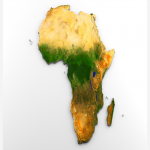It is 400 years since the first recorded African slaves arrived in North America to work plantations in English colonies. In the centuries after, European slave traders shipped millions of African men, women and children across the Atlantic Ocean. Many died in horrific conditions on the slave boats, while survivors endured a life of misery and backbreaking farm work.
For some of them, the terrible journey began here, deep inside Ghana. Captured by slavers, they were marched along dirt tracks for 200 kilometers (125 miles) to slave castles perched on the Atlantic Coast, where they boarded ships for North America. They never saw their homeland again.
From here in Adidwan, the slaves were forced south, passing through the gold-mining town of Obuasi.
Near the journey's end in Ghana, the captives were given a last, ritual bath in a river before being sold.
After they bathed in the river, the captives were then taken on the final leg of their journey in Ghana, to the last place they'd ever see in their homeland: slave forts on the Atlantic like the Cape Coast and Elmina castles.
From the castles, where European authorities lived in comfort right above the dungeons that held the slaves, the captured Africans walked through the Door of No Return onto the ships that would take them to America
But many rulers of West African empires, such as the Ashanti kingdom, whose descendants still live in this part of modern-day Ghana, also profited, selling captured slaves in exchange for guns, cloth, alcohol and other Western manufactured goods.
400 years old, the tales and stories told are still fresh in the memories of generations that were not born then but have traced their lineage and history.







